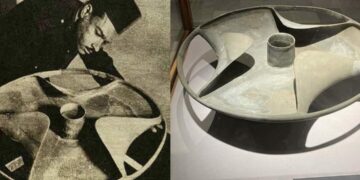For centuries, the Inuit and the Yupik people of Alaska and northern Canada have relied on snow goggles to help them navigate the harsh winter conditions of the Arctic. These ingenious devices, crafted from materials such as bone, ivory, wood, or antler, not only protected the wearer’s eyes from the glare of the sun reflecting off the snow, but also enhanced their vision in low light conditions. With their narrow slits, the goggles allowed Inuit hunters to spot prey in the distance, even on the darkest days of winter. But these goggles were more than just practical tools – they were also works of art, intricately carved with beautiful designs and often passed down from generation to generation.
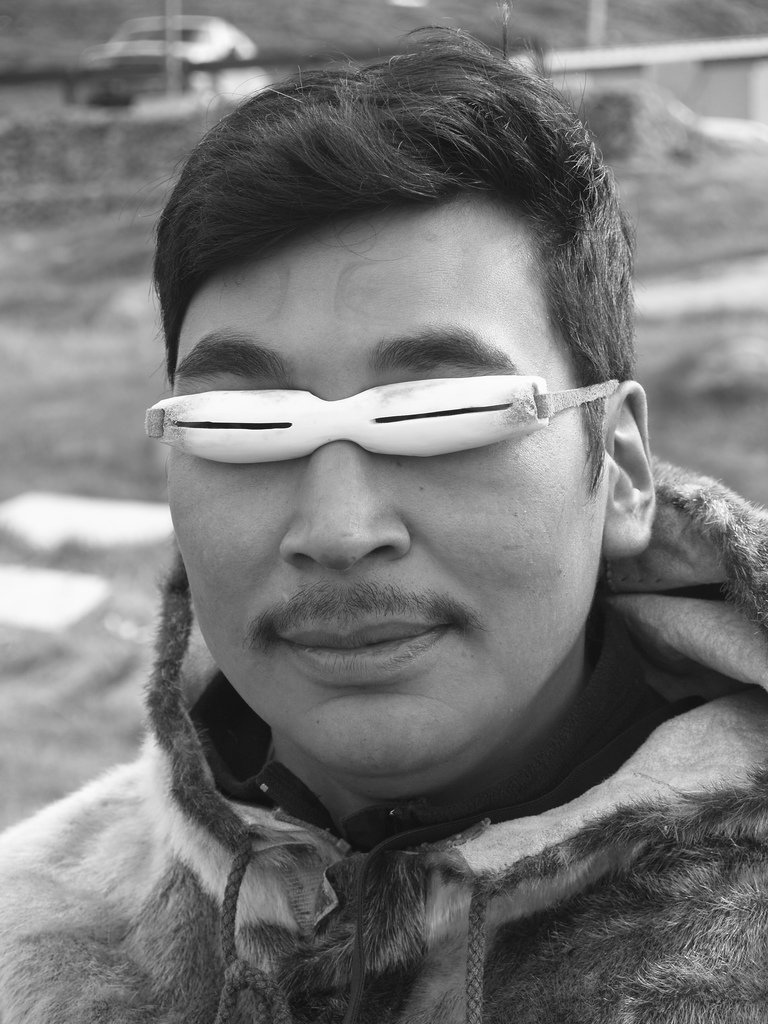
The history and evolution of Inuit snow goggles
The history of Inuit snow goggle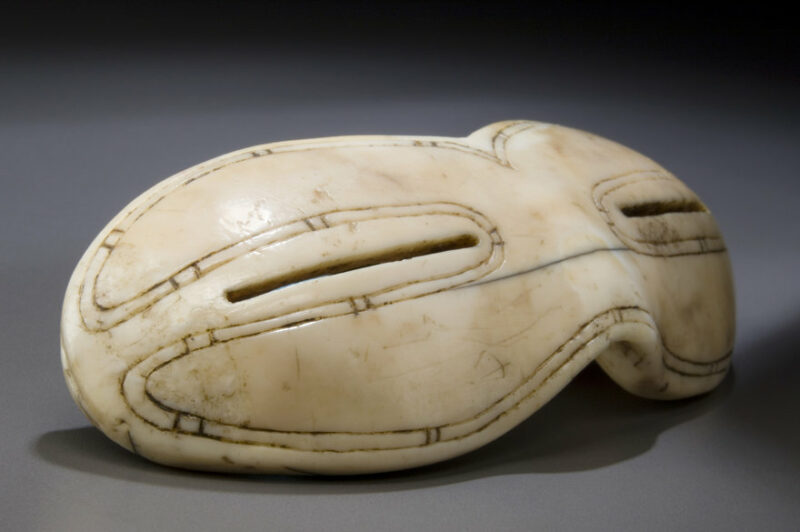
Over time, the design of Inuit snow goggles evolved and became more complex. The slits in the front of the goggles became wider, allowing for greater visibility, and the goggles themselves became more elaborate in their design. By the 19th century, Inuit snow goggles had become highly specialized tools, with different designs and materials used for different purposes. Some goggles were designed for hunting, with narrow slits and a streamlined shape to reduce wind resistance, while others were made for travel, with wider slits and a more comfortable fit.
Despite the many variations in design, all Inuit snow goggles shared a common purpose – to protect the eyes from the harsh glare of the sun reflecting off the snow. The evolution of these goggles is a testament to the ingenuity and resourcefulness of the Inuit people, who were able to adapt and innovate in order to survive in one of the harshest environments on Earth.
Materials used to make Inuit snow goggles
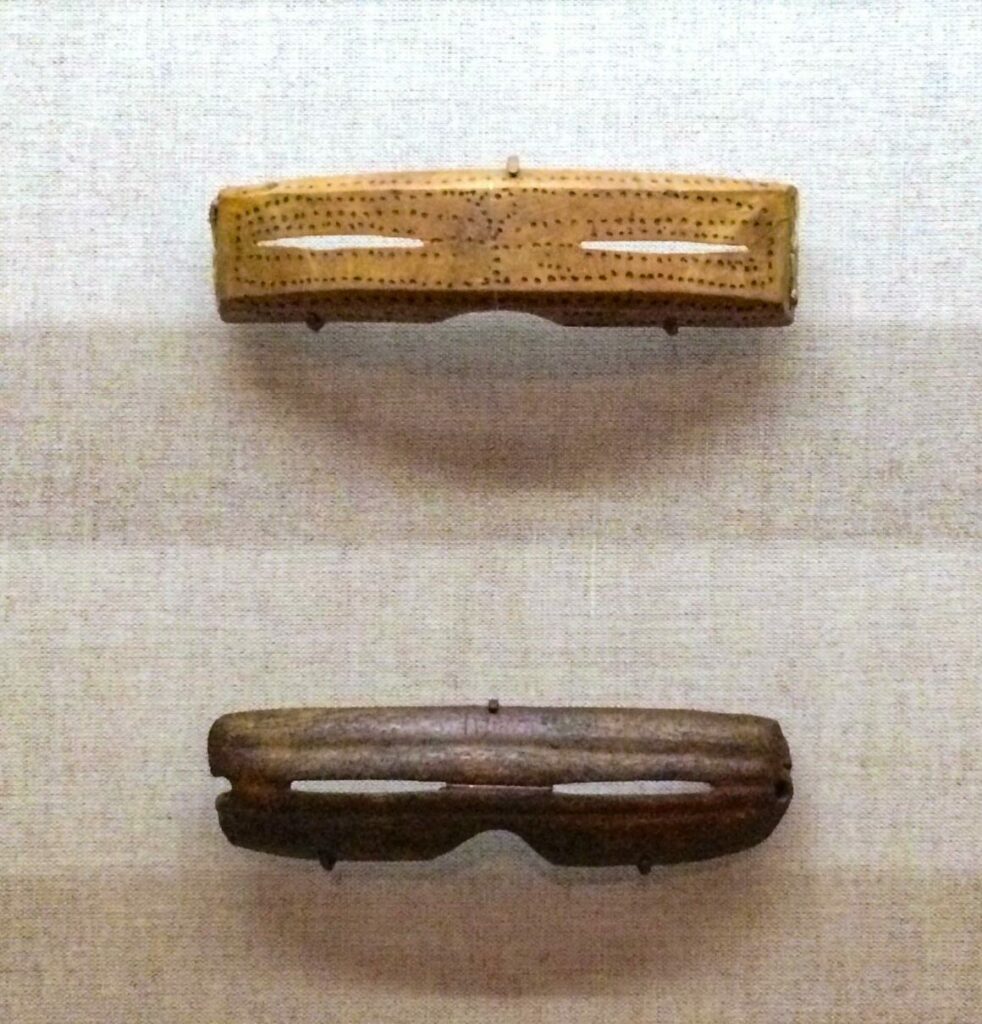
Inuit snow goggles were traditionally made from a variety of materials, including bone, ivory, wood, and antler. Each material had its own unique properties and was chosen for its suitability in making snow goggles.
Bone and ivory were the most commonly used materials for making Inuit snow goggles. These materials were readily available to the Inuit people and were easy to carve into the desired shape. Bone and ivory goggles were typically made from the jawbone of a large mammal, such as a walrus or a whale, and were highly prized for their durability and strength.
Wood was also used to make Inuit snow goggles, although this was less common than bone and ivory. Wooden goggles were typically made from birch or willow and were carved into the desired shape using a knife or other sharp tool.
Antler was another material that was occasionally used to make Inuit snow goggles. Antler goggles were typically made from the antlers of a caribou or a reindeer, which were carved into the desired shape and then polished to a smooth finish.
The functional purpose of Inuit snow goggles
The primary function of Inuit snow goggles was to protect the eyes from the harsh glare of the sun reflecting off the snow. This glare, known as “snow blindness,” can cause temporary or permanent vision loss if left untreated.
Inuit snow goggles were designed to prevent snow blindness by filtering out the harmful rays of the sun. The narrow slits in the front of the goggles allowed for visibility while blocking out the bright light of the sun. The design of the goggles also helped to reduce the amount of light entering the eyes, which further minimized the risk of permanent snow blindness.
In addition to protecting the eyes from snow blindness, Inuit snow goggles were also effective at protecting the eyes from the wind and cold. The goggles helped to prevent tears from freezing on the face, which could cause discomfort and even frostbite.
Prof. Mogens Norn, a Danish ophthalmologist, has noted that the Inuit snow goggles are superior to regular goggles or shades in polar conditions as they do not fog up or accumulate ice. Prof. Norn was impressed by the effectiveness and ease of use of the Inuit snow goggles when evaluating their practicality.
The cultural significance of Inuit snow goggles
Beyond their functional purpose, Inuit snow goggles also had a rich cultural significance. Each pair of goggles was often decorated with intricate carvings and designs that told stories of the Inuit way of life.
These carvings and designs were often symbolic, representing important aspects of Inuit culture such as hunting, fishing, and spirituality. Some goggles featured animals or other natural elements, while others were adorned with geometric patterns or abstract designs.
In many cases, the carvings on Inuit snow goggles were passed down from generation to generation, with each new pair of goggles telling a unique story about the wearer’s family and cultural heritage.
Traditional designs and carvings found on Inuit snow goggles

Inuit snow goggles were often decorated with intricate carvings and designs that reflected the wearer’s cultural heritage. Some of the most common designs and carvings found on Inuit snow goggles include:
Animal motifs: Many Inuit snow goggles were decorated with carvings of animals such as polar bears, caribou, and seals. These animals were often depicted in a stylized form, with exaggerated features and intricate patterns.
Geometric patterns: Inuit snow goggles were also often decorated with geometric patterns, such as triangles, squares, and circles. These patterns were often symbolic and represented important aspects of Inuit culture, such as the four cardinal directions.
Abstract designs: Some Inuit snow goggles featured abstract designs, such as swirls, spirals, and other intricate patterns. These designs were often highly stylized and were meant to represent the spiritual and mystical aspects of Inuit culture.
The artistry and craftsmanship involved in making Inuit snow goggles
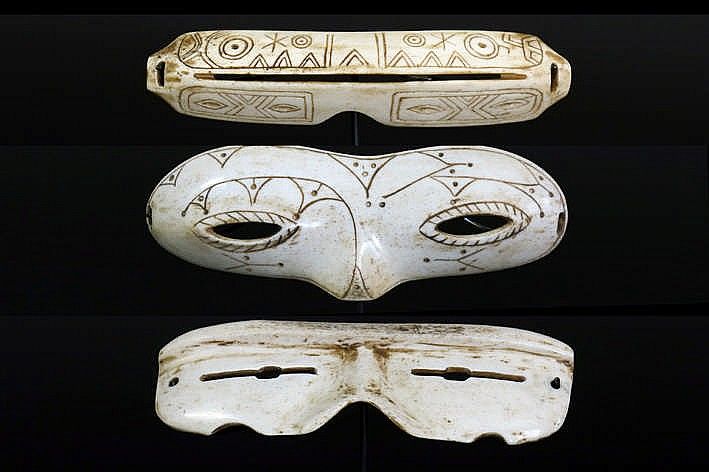
The process of making Inuit snow goggles was a highly skilled craft that required years of training and experience. The first step in making snow goggles was to select the appropriate material, such as bone, ivory, wood, or antler.
Once the material had been selected, the craftsman would use a knife or other sharp tool to carve the material into the desired shape. The slits in the front of the goggles were carefully carved to provide the optimal amount of visibility while blocking out the bright light of the sun.
After the goggles had been carved, they were often decorated with intricate carvings and designs. This was a highly skilled process that required a great deal of artistry and patience. The carvings were often symbolic and represented important aspects of Inuit culture, such as hunting, fishing, and spirituality.
Inuit Snow Goggles in Modern Times
Today, Inuit snow goggles are still used by some members of the Inuit community, particularly those who live in remote areas of the Arctic. However, the use of snow goggles has become less common in recent years, as modern technology has made it easier to protect the eyes from the harsh glare of the sun.
Despite this, Inuit snow goggles continue to hold a special place in Inuit culture, and their unique designs and carvings are still appreciated by collectors and enthusiasts around the world.
Where to see and purchase Inuit snow goggles
If you’re interested in seeing or purchasing Inuit snow goggles, there are a few places where you can find them. Many museums and cultural institutions have collections of Inuit snow goggles on display, where you can learn more about their history and cultural significance.
You can also find Inuit snow goggles for sale online or in specialty shops that specialize in Inuit art and artifacts. These goggles can be quite expensive, as they are often handmade and highly prized by collectors.
Conclusion
Inuit snow goggles are a remarkable testament to the ingenuity and resourcefulness of the Inuit people, who have learned to survive in one of the harshest environments on Earth. These goggles are not only practical but also beautifully crafted, with intricate designs and carvings that tell stories of Inuit culture and heritage.
While Inuit snow goggles are less commonly used today than in the past, they continue to hold a special place in Inuit culture, and their unique designs and carvings are still appreciated by collectors and enthusiasts around the world.





